A reader was intrigued by a handful of concrete structures resembling skateboard ramps on a grassy area off The Paseo, near 58th Street and Lydia Avenue — and reached out to What’s Your KCQ?, a collaboration between The Kansas City Public Library and The Kansas City Star, for an explanation.
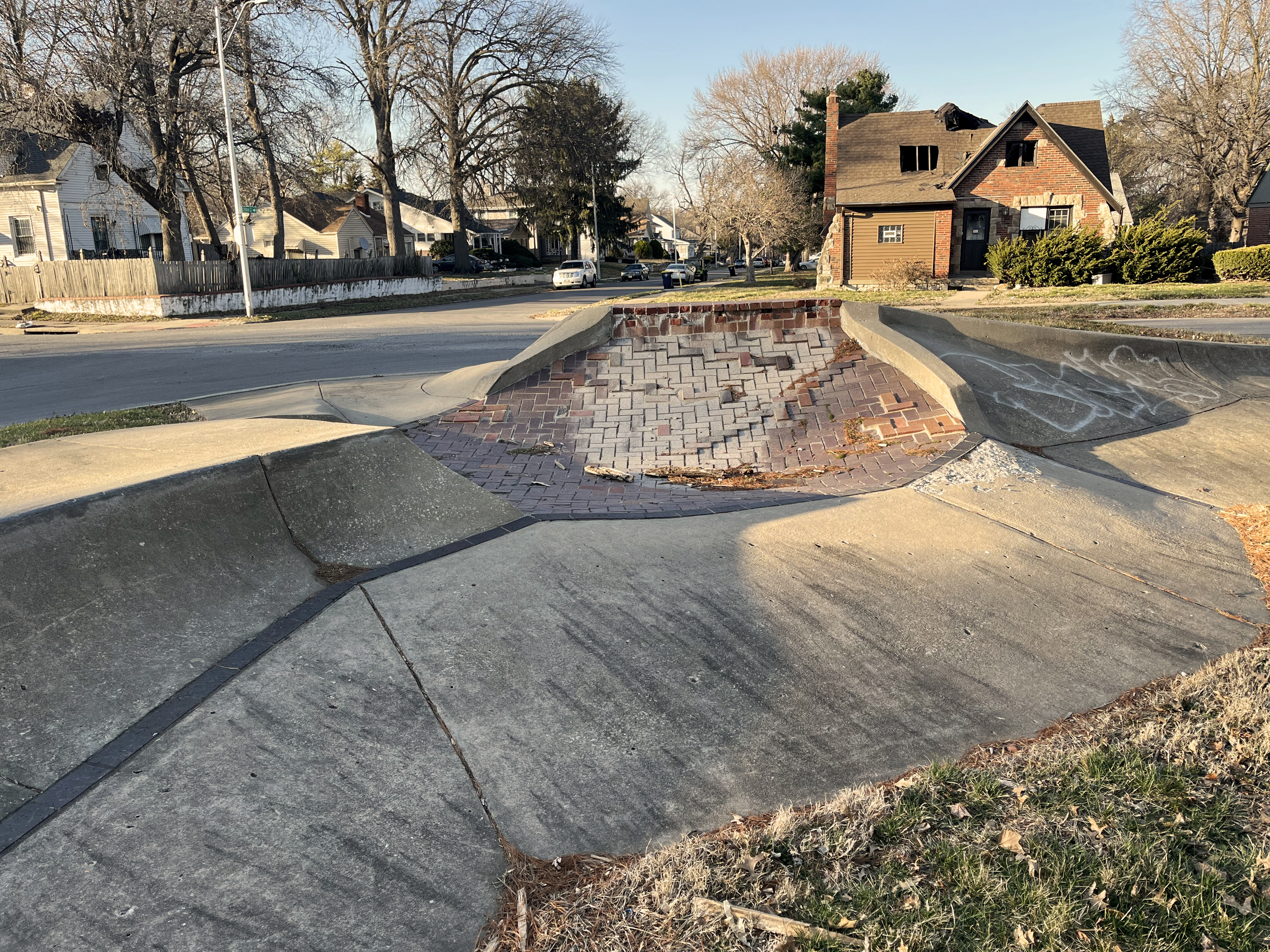
One of the concrete forms near 58th Street and The Paseo.
From a distance, these curved concrete surfaces bear a resemblance to ramps at a skatepark. But a closer look reveals gentle slopes interspersed with grassy patches, which would make skateboarding impractical.
Instead, this is the site of the 49/63 Neighborhood Fountain, owned and maintained by Kansas City Parks and Recreation. Unfortunately, the fountain is not currently operational.
In the early 1980s, the 49/63 Neighborhood Coalition sought to visually enhance this part of Kansas City, east and west of Troost — from Martin Luther King, Jr. Boulevard to 63rd Street, and from Oak Street to The Paseo.
The Coalition, a collective of residential associations, reached out to Will Nettleship. The sculptor moved to Kansas City in 1971 and was known for creating a series of concrete boundary markers in his own neighborhood of Hyde Park. Placed at 39th and Holmes and at Gillham Road and Locust, the markers were modeled after the historic Janssen Place entryway on 36th Street.
Members of the 49/63 Coalition wanted something similar.

One of Nettleship’s Hyde Park markers at 39th Street and Gilham Road.
Nettleship was born in Indianapolis, Indiana, and raised in California. After graduating from Columbia University in New York with a history degree, he received an MFA in sculpture from the University of Arkansas.
He says he felt drawn to Kansas City’s lush green spaces and interesting terrain — and relocated here. In addition to his sculpture, Nettleship paid the bills through teaching and with commissions for decorative ironworks.
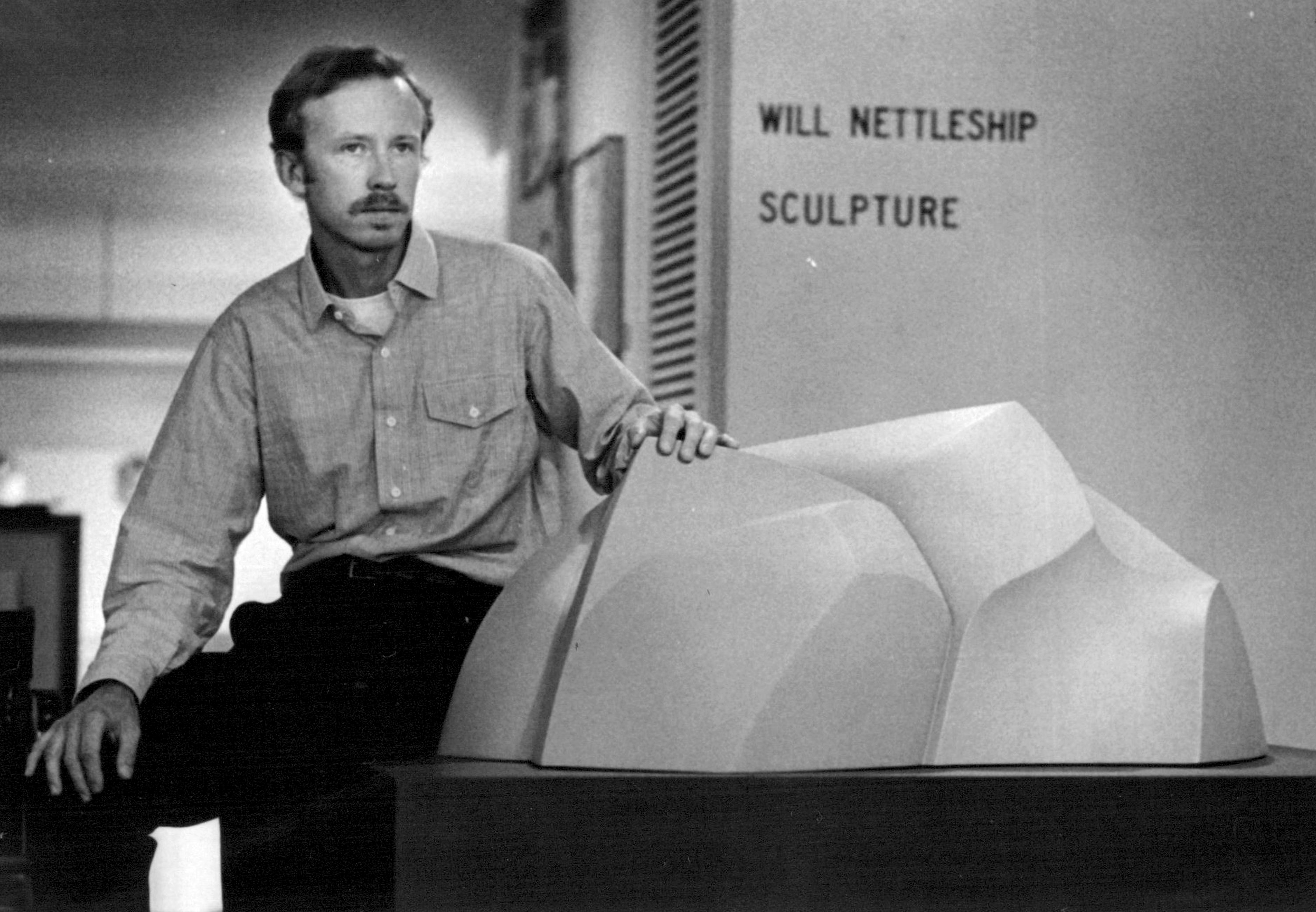
Will Nettleship with a cast concrete landscape sculpture in 1979. THE KANSAS CITY STAR
According to Nettleship, sculpture is a tactile as well as a visual art form.
“I do believe that it is only partially a visual art,” he wrote by email, “and that it draws on body language, what we feel when we touch and also what we feel within our bodies as we move.”
This guided his multi-decade career, creating public art designed for human interaction.
Nettleship noticed that many Midtown buildings along Troost and other prominent streets were constructed of pale, yellow brick. This was a starting point for the design of the 49/63 Neighborhood markers, which were also abstract sculptures.
“My hope is to build something,” he said, “that both reflects and enhances … the history, natural or cultural, of the area.”

Troost Elementary School, constructed with the yellow brick that inspired Nettleship, at 1215 E. 59th in the 49/63 Neighborhood.
Black brick was used in the markers as a decorative element. And, inspired by the blue and white tile in the street markers embedded in the sidewalks of many other Midtown intersections, Nettleship added similar enameled 49/63 Neighborhood signs.
“The markers are ten-sided to make them as interesting as possible from every side,” he said. “And the tops are concrete castings that I made in my studio.”
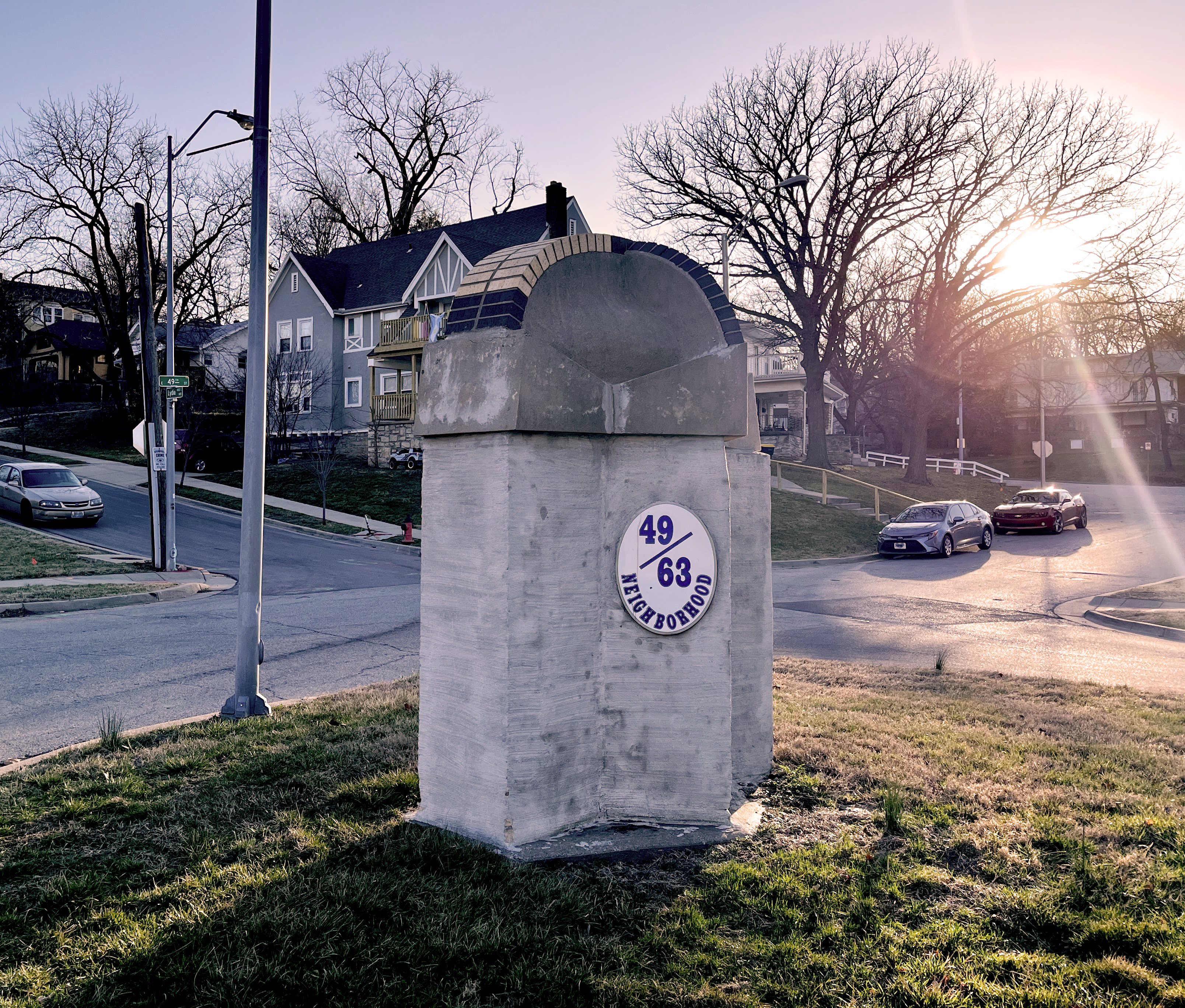
The 49/63 Neighborhood marker at 49th Street and The Paseo.
The nine-foot markers were installed in 1982 at three points — 49th Street and The Paseo, 59th Street and The Paseo, and 49th Street and Troost. Unfortunately, the Troost marker was removed at some point.
Nettleship said he was inspired by his observations in nature to create his cast concrete forms.
He recalled setting off with a friend on a homemade raft from Riverfront Park east of downtown Kansas City in June 1973. The duo planned to raft down the Missouri and Mississippi rivers to New Orleans. Unfortunately, due to setbacks, they abandoned the journey in Helena, Arkansas.
“The water ripples and whorls, and also the ever-shifting sand on the banks and islands,” Nettleship described, “(these) were forms I found inspirational as a young sculptor.”
He poured this sensibility into a new project when the 49/63 Coalition approached him again to design the 49/63 Neighborhood Fountain, which was completed in 1983.
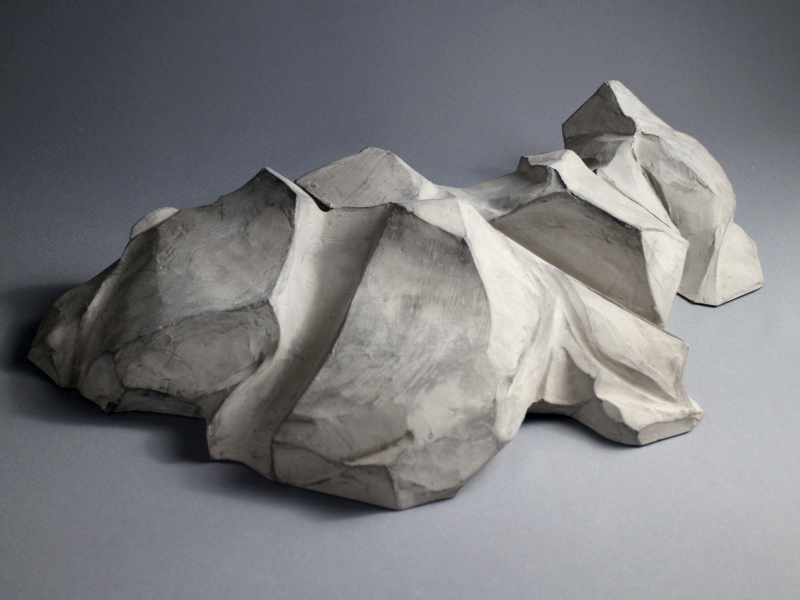
One of Nettleship’s cast concrete landscape sculptures. WILL NETTLESHIP
“They didn’t want a pond,” Nettleship said. “They wanted it back on this side (away from The Paseo) so the kids wouldn’t be running into the street.”
The primary motivation, he said, was to create a neighborhood gathering place where residents could sit, socialize, and relax.
The 49/63 Neighborhood Fountain in 1984.
The Coalition did include one stipulation: “little maintenance.” And Nettleship listened.
“The shapes are designed to create sitting areas,” he said, “and, although concrete, to be as comfortable as such a material can be.”
Nettleship created the fountain with simplicity and ease of use in mind. It was designed so water would flow from several small pipes, over a brick design, and into a drain below.
“The thought was to create a sound feature of a brook for those sitting on the nearby raised forms. As additional funds became available, we added the outlying concrete forms,” he recalled. Together with the fountain, these are the skateboard ramp like forms noticed by our reader.
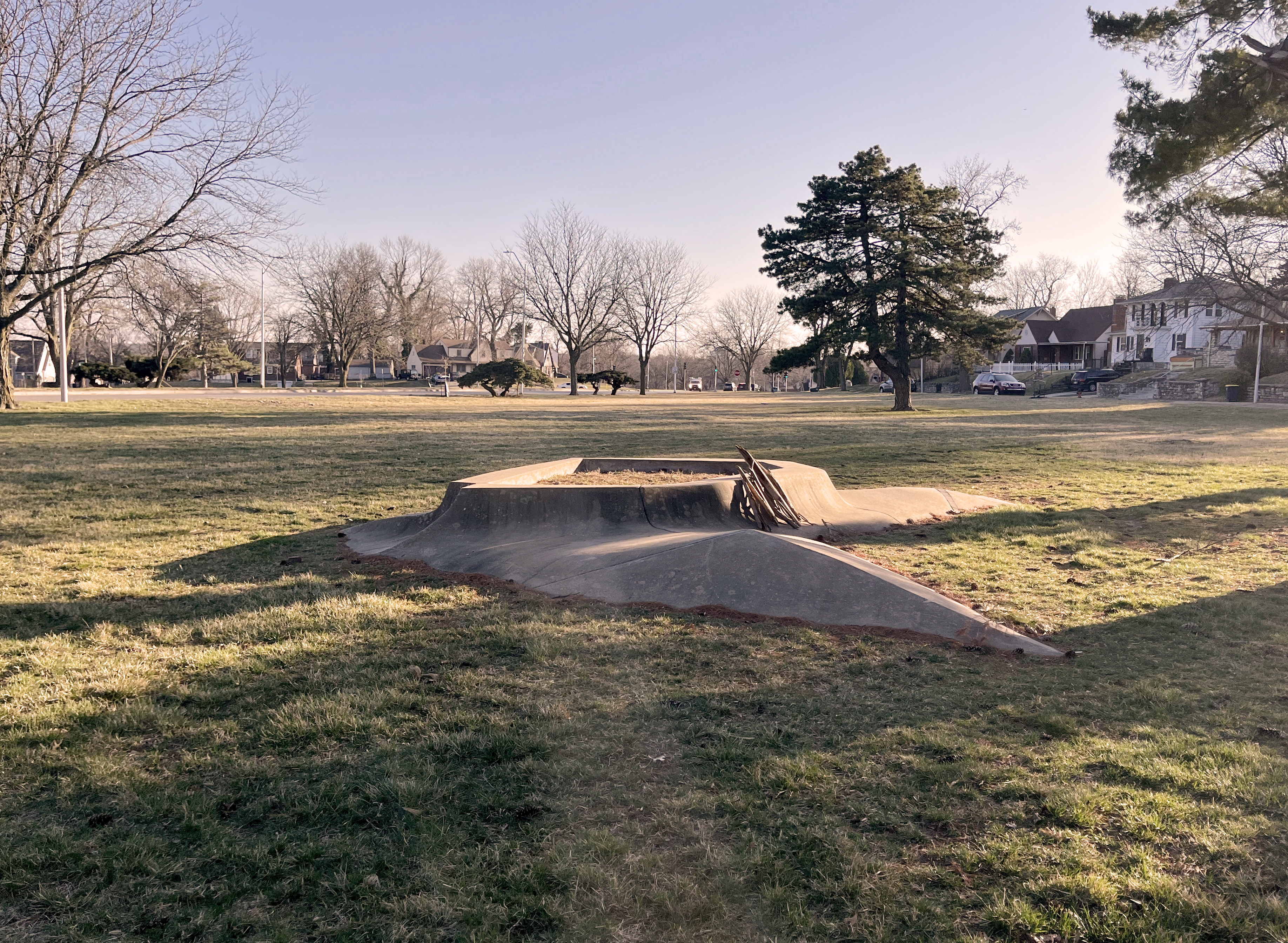
One of the concrete sitting areas adjacent to the fountain.
The fountain was formally dedicated on Nov. 6, 1983, and received the Municipal Art Commission’s Award of Excellence the following year.
Nettleship, who now lives in California, has continued his work as a sculptor, always remaining true to his belief that sculpture should be felt and experienced in a variety of ways. In addition to his installations in the Kansas City area, Nettleship’s public art projects can also be found along both U.S. coasts, in the Southwest, and in Europe.

“Centuries in Turn” was designed by Nettleship for the central courtyard of William Woods University in Fulton, Missouri. WILL NETTLESHIP
Nettleship expressed his gratitude to the city’s parks department and other municipal agencies for helping the 49/63 projects become a reality.
“I do hope that the people in the 49/63 Neighborhood have enjoyed the public space created by the fountain features,” he said, “and that the markers have contributed to a sense of place and pride for residents.”
While the fountain may be in a state of disrepair, residents can still take advantage of the open green space and concrete benches. Last month, Kansas City Parks and Recreation stated that, with the assistance of the City of Fountains Foundation, a master plan covering repairs, improvements, and ongoing maintenance is being developed, and that the 49/63 Neighborhood Fountain will be included.
SUBMIT A QUESTION
Do you want to ask a question for a future voting round? Kansas City Star reporters and Kansas City Public Library researchers will investigate the question and explain how we got the answer. Enter it below to get started.

